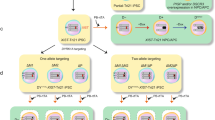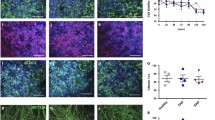Abstract
Several methods have been used to study the neuropathogenesis of Down syndrome (DS), such as mouse aneuploidies, post mortem human brains, and in vitro cell culture of neural progenitor cells. More recently, induced pluripotent stem cell (iPSC) technology has offered new approaches in investigation, providing a valuable tool for studying specific cell types affected by DS, especially neurons and astrocytes. Here, we investigated the role of astrocytes in DS developmental disease and the impact of the astrocyte secretome in neuron mTOR signaling and synapse formation using iPSC derived from DS and wild-type (WT) subjects. We demonstrated for the first time that DS neurons derived from hiPSC recapitulate the hyperactivation of the Akt/mTOR axis observed in DS brains and that DS astrocytes may play a key role in this dysfunction. Our results bear out that 21 trisomy in astrocytes contributes to neuronal abnormalities in addition to cell autonomous dysfunctions caused by 21 trisomy in neurons. Further research in this direction will likely yield additional insights, thereby improving our understanding of DS and potentially facilitating the development of new therapeutic approaches.







Similar content being viewed by others
References
Starbuck JM (2011) On the antiquity of trisomy 21: moving towards a quantitative diagnosis of Down syndrome in historic material culture. scholarworks.iupui.edu
Lott IT, Head E (2001) Down syndrome and Alzheimer’s disease: a link between development and aging. Ment Retard Dev Disabil Res Rev 7:172–178. https://doi.org/10.1002/mrdd.1025
Araujo BH, Torres LB, Guilhoto LM (2015) Cerebal overinhibition could be the basis for the high prevalence of epilepsy in persons with Down syndrome. Epilepsy Behav 53:120–125. https://doi.org/10.1016/j.yebeh.2015.10.004
Arya R, Kabra M, Gulati S (2011) Epilepsy in children with Down syndrome. Epileptic Disord 13:1–7. https://doi.org/10.1684/epd.2011.0415
Smigielska-Kuzia J, Sobaniec W, Kułak W, Boćkowski L (2009) Clinical and EEG features of epilepsy in children and adolescents in Down syndrome. J Child Neurol 24:416–420. https://doi.org/10.1177/0883073808324542
Chakrabarti L, Best TK, Cramer NP, Carney RS, Isaac JT, Galdzicki Z, Haydar TF (2010) Olig1 and Olig2 triplication causes developmental brain defects in Down syndrome. Nat Neurosci 13:927–934. https://doi.org/10.1038/nn.2600
Becker L, Mito T, Takashima S, Onodera K (1991) Growth and development of the brain in Down syndrome. Prog Clin Biol Res 373:133–152
Haydar TF (2005) Advanced microscopic imaging methods to investigate cortical development and the etiology of mental retardation. Ment Retard Dev Disabil Res Rev 11:303–316. https://doi.org/10.1002/mrdd.20088
Chen C, Jiang P, Xue H, Peterson SE, Tran HT, McCann AE, Parast MM, Li S et al (2014) Role of astroglia in Down’s syndrome revealed by patient-derived human-induced pluripotent stem cells. Nat Commun 5:4430. https://doi.org/10.1038/ncomms5430
HE L, Yang YC, Chen SM, HL S, Huang PC, Tsai MS, Wang TH, Tseng CP et al (2013) Modeling neurogenesis impairment in Down syndrome with induced pluripotent stem cells from Trisomy 21 amniotic fluid cells. Exp Cell Res 319:498–505. https://doi.org/10.1016/j.yexcr.2012.09.017
Dazert E, Hall MN (2011) mTOR signaling in disease. Curr Opin Cell Biol 23:744–755. https://doi.org/10.1016/j.ceb.2011.09.003
Laplante M, Sabatini DM (2012) mTOR signaling in growth control and disease. Cell 149:274–293. https://doi.org/10.1016/j.cell.2012.03.017
Wong M (2013) Mammalian target of rapamycin (mTOR) pathways in neurological diseases. Biom J 36:40–50. https://doi.org/10.4103/2319-4170.110365
Orlova KA, Crino PB (2010) The tuberous sclerosis complex. Ann N Y Acad Sci 1184:87–105. https://doi.org/10.1111/j.1749-6632.2009.05117.x
Tsai PT, Hull C, Chu Y, Greene-Colozzi E, Sadowski AR, Leech JM, Steinberg J, Crawley JN et al (2012) Autistic-like behaviour and cerebellar dysfunction in Purkinje cell Tsc1 mutant mice. Nature 488:647–651. https://doi.org/10.1038/nature11310
Iyer AM, van Scheppingen J, Milenkovic I, Anink JJ, Adle-Biassette H, Kovacs GG, Aronica E (2014) mTOR Hyperactivation in down syndrome hippocampus appears early during development. J Neuropathol Exp Neurol 73:671–683. https://doi.org/10.1097/NEN.0000000000000083
Perluigi M, Pupo G, Tramutola A, Cini C, Coccia R, Barone E, Head E, Butterfield DA et al (2014) Neuropathological role of PI3K/Akt/mTOR axis in Down syndrome brain. Biochim Biophys Acta 1842:1144–1153. https://doi.org/10.1016/j.bbadis.2014.04.007
Troca-Marín JA, Alves-Sampaio A, Montesinos ML (2011) An increase in basal BDNF provokes hyperactivation of the Akt-mammalian target of rapamycin pathway and deregulation of local dendritic translation in a mouse model of Down’s syndrome. J Neurosci 31:9445–9455. https://doi.org/10.1523/JNEUROSCI.0011-11.2011
Clarke LE, Barres BA (2013) Emerging roles of astrocytes in neural circuit development. Nat Rev Neurosci 14:311–321. https://doi.org/10.1038/nrn3484
Ullian EM, Sapperstein SK, Christopherson KS, Barres BA (2001) Control of synapse number by glia. Science 291:657–661. https://doi.org/10.1126/science.291.5504.657
Williams EC, Zhong X, Mohamed A, Li R, Liu Y, Dong Q, Ananiev GE, Mok JC et al (2014) Mutant astrocytes differentiated from Rett syndrome patients-specific iPSCs have adverse effects on wild-type neurons. Hum Mol Genet 23:2968–2980. https://doi.org/10.1093/hmg/ddu008
Kıray H, Lindsay SL, Hosseinzadeh S, Barnett SC (2016) The multifaceted role of astrocytes in regulating myelination. Exp Neurol 283:541–549. https://doi.org/10.1016/j.expneurol.2016.03.009
Okita K, Matsumura Y, Sato Y, Okada A, Morizane A, Okamoto S, Hong H, Nakagawa M et al (2011) A more efficient method to generate integration-free human iPS cells. Nat Methods 8:409–412. https://doi.org/10.1038/nmeth.1591
Jehee FS, Takamori JT, Medeiros PF, Pordeus AC, Latini FR, Bertola DR, Kim CA, Passos-Bueno MR (2011) Using a combination of MLPA kits to detect chromosomal imbalances in patients with multiple congenital anomalies and mental retardation is a valuable choice for developing countries. Eur J Med Genet 54:e425–e432. https://doi.org/10.1016/j.ejmg.2011.03.007
de Souza JS, Carromeu C, Torres LB, Araujo BH, Cugola FR, Maciel RM, Muotri AR, Giannocco G (2017) IGF1 neuronal response in the absence of MECP2 is dependent on TRalpha 3. Hum Mol Genet 26:270–281. https://doi.org/10.1093/hmg/ddw384
Nageshappa S, Carromeu C, Trujillo CA, Mesci P, Espuny-Camacho I, Pasciuto E, Vanderhaeghen P, Verfaillie CM et al. (2016) Altered neuronal network and rescue in a human MECP2 duplication model. Mol Psychiatry 21(2):178–88. https://doi.org/10.1038/mp.2015.128
Halevy T, Biancotti JC, Yanuka O, Golan-Lev T, Benvenisty N (2016) Molecular characterization of down syndrome embryonic stem cells reveals a role for RUNX1 in neural differentiation. Stem Cell Reports 7:777–786. https://doi.org/10.1016/j.stemcr.2016.08.003
Christopherson KS, Ullian EM, Stokes CC, Mullowney CE, Hell JW, Agah A, Lawler J, Mosher DF et al (2005) Thrombospondins are astrocyte-secreted proteins that promote CNS synaptogenesis. Cell 120:421–433. https://doi.org/10.1016/j.cell.2004.12.020
Mauch DH, Nägler K, Schumacher S, Göritz C, Müller EC, Otto A, Pfrieger FW (2001) CNS synaptogenesis promoted by glia-derived cholesterol. Science 294:1354–1357. https://doi.org/10.1126/science.294.5545.1354
Fernandez F, Morishita W, Zuniga E, Nguyen J, Blank M, Malenka RC, Garner CC (2007) Pharmacotherapy for cognitive impairment in a mouse model of Down syndrome. Nat Neurosci 10:411–413. https://doi.org/10.1038/nn1860
Weick JP, Held DL, Bonadurer GF, Doers ME, Liu Y, Maguire C, Clark A, Knackert JA et al (2013) Deficits in human trisomy 21 iPSCs and neurons. Proc Natl Acad Sci U S A 110:9962–9967. https://doi.org/10.1073/pnas.1216575110
Garcia O, Torres M, Helguera P, Coskun P, Busciglio J (2010) A role for thrombospondin-1 deficits in astrocyte-mediated spine and synaptic pathology in Down’s syndrome. PLoS One 5:e14200. https://doi.org/10.1371/journal.pone.0014200
Kemper TL (1991) Down syndrome. In: Peters A, Jones EG (eds) Normal and Altered States of Function. Cereb Cortex, vol 9. Springer, Boston, pp 511–526
Engidawork E, Lubec G (2003) Molecular changes in fetal Down syndrome brain. J Neurochem 84:895–904
Guihard-Costa AM, Khung S, Delbecque K, Ménez F, Delezoide AL (2006) Biometry of face and brain in fetuses with trisomy 21. Pediatr Res 59:33–38. https://doi.org/10.1203/01.pdr.0000190580.88391.9a
Kassai H, Sugaya Y, Noda S, Nakao K, Maeda T, Kano M, Aiba A (2014) Selective activation of mTORC1 signaling recapitulates microcephaly, tuberous sclerosis, and neurodegenerative diseases. Cell Rep 7:1626–1639. https://doi.org/10.1016/j.celrep.2014.04.048
Gómez-Casati ME, Murtie JC, Rio C, Stankovic K, Liberman MC, Corfas G (2010) Nonneuronal cells regulate synapse formation in the vestibular sensory epithelium via erbB-dependent BDNF expression. Proc Natl Acad Sci U S A 107:17005–17010. https://doi.org/10.1073/pnas.1008938107
Allen NJ, Bennett ML, Foo LC, Wang GX, Chakraborty C, Smith SJ, Barres BA (2012) Astrocyte glypicans 4 and 6 promote formation of excitatory synapses via GluA1 AMPA receptors. Nature 486:410–414. https://doi.org/10.1038/nature11059
Farías GG, Alfaro IE, Cerpa W, Grabowski CP, Godoy JA, Bonansco C, Inestrosa NC (2009) Wnt-5a/JNK signaling promotes the clustering of PSD-95 in hippocampal neurons. J Biol Chem 284:15857–15866. https://doi.org/10.1074/jbc.M808986200
Weston MC, Chen H, Swann JW (2012) Multiple roles for mammalian target of rapamycin signaling in both glutamatergic and GABAergic synaptic transmission. J Neurosci 32:11441–11452. https://doi.org/10.1523/JNEUROSCI.1283-12.2012
Zhang L, Zhang S, Yao J, Lowery FJ, Zhang Q, Huang WC, Li P, Li M et al (2015) Microenvironment-induced PTEN loss by exosomal microRNA primes brain metastasis outgrowth. Nature 527:100–104. https://doi.org/10.1038/nature15376
Demirci S, Doğan A, Apdik H, Tuysuz EC, Gulluoglu S, Bayrak OF, Şahin F (2017) Cytoglobin inhibits migration through PI3K/AKT/mTOR pathway in fibroblast cells. Mol Cell Biochem. https://doi.org/10.1007/s11010-017-3101-2
Turner N, Grose R (2010) Fibroblast growth factor signalling: from development to cancer. Nat Rev Cancer 10:116–129. https://doi.org/10.1038/nrc2780
Midorikawa Y, Ishikawa S, Iwanari H, Imamura T, Sakamoto H, Miyazono K, Kodama T, Makuuchi M et al (2003) Glypican-3, overexpressed in hepatocellular carcinoma, modulates FGF2 and BMP-7 signaling. Int J Cancer 103:455–465. https://doi.org/10.1002/ijc.10856
Maiese K (2015) Neuronal activity, mitogens, and mTOR: overcoming the hurdles for the treatment of glioblastoma multiforme. J Transl Sci 1:2
Venkatesh HS, Johung TB, Caretti V, Noll A, Tang Y, Nagaraja S, Gibson EM, Mount CW et al (2015) Neuronal activity promotes glioma growth through neuroligin-3 secretion. Cell 161:803–816. https://doi.org/10.1016/j.cell.2015.04.012
Zhou J, Su P, Wang L, Chen J, Zimmermann M, Genbacev O, Afonja O, Horne MC et al (2009) mTOR supports long-term self-renewal and suppresses mesoderm and endoderm activities of human embryonic stem cells. Proc Natl Acad Sci U S A 106:7840–7845. https://doi.org/10.1073/pnas.0901854106
Funding
This study was supported by grants from Fundação de Amparo à Pesquisa do Estado de São Paulo (FAPESP; Centros de Pesquisa, Inovação e Difusão (CEPID), number 2013/08028-1). Bruno H. S. Araujo, Ernesto Goulart, and Luiz C. J. Caires are fellows of FAPESP (2014/08049-1; 2015/14821-1; 2017/16283-2); Carolini Kaid and Camila M. Musso are fellows of Coordenação de Aperfeiçoamento de Pessoal de Nível Superior (CAPES; 1469761; 1470032); Janaina S. de Souza is a fellow of Conselho Nacional de Desenvolvimento Científico e Tecnológico (CNPq; 18952-12-7).
Author information
Authors and Affiliations
Corresponding author
Ethics declarations
Conflict of Interest
The author(s) declare(s) that there is no conflict of interest regarding the publication of this article.
Electronic Supplementary Material
ESM 1
(DOCX 102 kb)
Rights and permissions
About this article
Cite this article
Araujo, B.H.S., Kaid, C., De Souza, J.S. et al. Down Syndrome iPSC-Derived Astrocytes Impair Neuronal Synaptogenesis and the mTOR Pathway In Vitro. Mol Neurobiol 55, 5962–5975 (2018). https://doi.org/10.1007/s12035-017-0818-6
Received:
Accepted:
Published:
Issue Date:
DOI: https://doi.org/10.1007/s12035-017-0818-6




